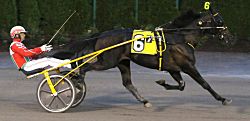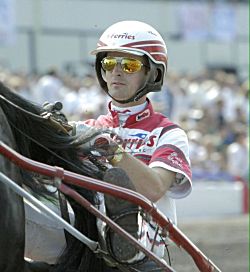Paul Kelley and Rene Sejthen have been a winning team
September 25, 2018,by Rich Fisher, USTA Web Newsroom Senior Correspondent

Rich Fisher
Trenton, NJ — Listening to Paul Kelley discuss Rene Sejthen, it’s hard to figure out if Kelley employs a trainer, a bass guitarist, or Nick Foles.
In discussing the chemistry he has formed over two years with his second trainer, who hails from Denmark by way of Sweden, Kelley noted, “It’s a relationship that has just kind of grown and gotten better and better. The more we work together — it’s like a band. You put a band together and the more they start playing the more the musicians kind of get to know one another. They trade off one another and the better they sound. That’s kind of the way I see it. It’s pretty cool.”
And while Sejthen’s main responsibilities are to shoe and train, it doesn’t hurt that he can climb in the sulky when need be. He has not driven a lot, but Kelley feels confident giving him the lines.
“If the situation arises and I’ve got to turn to him, he’s like the back-up quarterback, no problem,” the trainer said. “I’ve always had somebody in the barn that’s been a good wing man. That’s what you need.”

Fred Brown photo
Rene Sejthen gained his first U.S. win on July 21 by driving Obrigado to victory at Tioga Downs.
And while it may not rank with Foles winning the Super Bowl, Mr. Back-Up QB gained his first U.S. win on July 21 by driving Obrigado to victory at Tioga Downs in the horse’s second race back after arthroscopic surgery in November. The 8-year-old Obrigado was the Dan Patch Award winner for best older male trotter in 2016.
“That was amazing to get that chance,” Sejthen said. “I had a couple of good horses in Denmark and Sweden, but if you look at Obri and how much he had been earning, he is one of the best I’ve driven. Last year we had a lot of trouble with him, he got surgery, so to get to drive the (second) race of his comeback, it was big.”
The fact Sejthen won was not entirely unexpected, as Kelley has nothing but praise for his Danish import. So much so, that when asked if the 43-year-old has a bright future, he began a witty backtrack.
“I would say so, but I don’t want to build him up too much because I want him to stay in my barn,” Kelley said with a laugh. “We’ve developed a really great relationship, I’ve got 100 percent trust in him. I think he’s got 100 percent trust in me and our interest is to make the stable as good as it can be and go out and hopefully win a Hambletonian and some other big races. That’s what we’re working for.”
Sejthen has been working toward it for a long time. Growing up in Aarhus, the second largest town in Denmark, his grandfather and father both owned horses and his dad was a trainer.
“I’ve always been around horses,” he said. “I got my first pony to drive in the pony races when I was 10 or 11 years old. They’ve always been special for me.”
Rene moved to Copenhagen at age 17. He soon began working the stables and, during a four-year stretch, was ranked among the top four trainers and top five drivers with more than 350 wins in the country’s capital city. After having such success, Sejthen used his contacts in Sweden to gain a job working there.
In retrospect, an ill-advised move.
“If you look backwards at it, I should never have done that,” Sejthen said. “It’s so much bigger in Sweden and there are so many more trainers. You could say it didn’t go as well in Sweden as it did when I was in Denmark.”
Sejthen gave it his best shot, sticking it out for 10 years before returning home. By then, the harness racing business had deteriorated in Denmark.
“When I came back home and saw how bad it was, I had two choices,” he said. “Either I had to find something else to do or I had to move. At that point I was in contact with some people in France and with some people I knew in the U.S. It was 50-50 what way to go at that moment. I decided to take a chance to come over here because for me it was easier with the language. I don’t speak any French.”

Photo courtesy of Facebook
Rene Sejthen was originally a top trainer and driver in his native Denmark.
Rene touched base with trainer Anette Lorentzon — he had known her father John Erik Magnusson from working in Sweden — and got a job with her in America six years ago. He stayed with Lorentzon for two years before working for another Swede, Ake Svanstedt. After two years there, Sejthen felt as if he was spinning his wheels.
“I was thinking I had to try to find some American trainer to work for to see how they operate,” he said. “To work for Ake, his operation was the same as it was for me in Sweden. So it was like; did I really move to the other side of the planet to work for a Swedish team? We had a good time when we moved over here and it was fun to help him get everything set up. But I wanted to try to see how an American operation worked.”
In one of those “sometimes life works out” situations, Kelley happened to be looking for a second trainer and Bjorn “Bernie” Noren, who worked for Svanstedt, set up a meeting with Sejthen at the 2016 Standardbred Horse Sale. The two talked things over for a few days and the band was ready to rock. One of the things that impressed Kelley the most was that Rene is a well-rounded horseman.
“He’s a blacksmith as well as a trainer and when he took the job it was understood he would do the shoeing for all the horses in the stable,” Kelley said. “It’s a great advantage for me as a trainer to have those kind of people in the barn because they’re sitting behind these horses every day and they’re right in the midst of the whole training process. They know all the little nuances of each horse.
“So when things need to get changed around, especially when you’re dealing with young trotters, it’s just a big advantage to have somebody right there in the barn who can make those adjustments. Sometimes those adjustments are done from race to race. It’s dependent on each horse and what’s going on. For me over the last 10 or 12 years, it’s been a great asset to have someone like that in the barn.”
Sejthen admittedly did not know much about Kelley’s operation when the two talked, but he knew that he was being given a good opportunity. Over the first two years, it has been even better than expected.
“It’s nice to work with somebody who sometimes asks you what you think instead of just being told what to do the whole time,” Rene said.
There is a reason for that. While Kelley has enjoyed success, he is smart enough to realize there is always more to learn about horses that trainers in the U.S. may not know about. Meanwhile, Sejthen is also learning some new tricks.
“He’s been exposed to different training techniques over here in North America,” Kelley said. “As Americans, we grow up learning our techniques and then there are other techniques and training regimens the Scandinavians have grown up learning. It’s been a nice blend of being able to do both with a guy like Rene in the barn.
“I try to be a very open-minded trainer and try to always learn new things. A lot of the guys that come from these different countries, whether Denmark, Norway, Sweden, Australia or New Zealand, all these countries are rich in harness racing. I give these guys credit, they want to see the world and come and see America and compete in America. We’re the lucky recipients on our end, they only enrich the game over here. It’s a good thing for us.
“Rene and I have developed a nice blend and I’ve learned a lot from him and I would hope he’s learned some things from me and we’ve been able to work really well together. Our relationship has grown immensely over the last couple of years.”
Sejthen is in complete agreement, saying there is a natural synergy between the two.
“We work well together,” he said. “We have some pretty good discussions, so when I come up with things and he comes up with things, we try it out. I think we have a good rapport.”
Kelley’s confidence in Sejthen’s driving ability was on full display when he gave him Obrigado to drive.
“I had no doubt he could handle the horse,” Kelley said. “He’s got a ton of experience, he knows that horse as well as I do, maybe in some ways he might even know him a little better. He sat behind him in a number of qualifying races and drove him that one race in Tioga. There isn’t a horse in the barn that I would have any problem having him take the post and drive for me if the situation was needed.
“I would rather have somebody I know take a horse like that rather than go to a B track to find a driver trying too hard to impress me with what he could do. My concerns are always with the horse’s welfare and Rene’s are the same so I knew he was more than qualified to handle that job.”
Sejthen says he loves to drive because he thrives on the competition. He also feels it can make him an even better trainer because he may be able to advise the catch drivers on certain traits a horse may have if he has already driven the horse. But he is quick to note he would never ask for more drives, saying only, “If one of Paul’s owners wants me to drive the horse now and then, I’m happy with that.”
As it is now, Rene is just happy to be able to be on the track for training and at the track for races. In the past, his primary responsibility was shoeing horses.
“The way we have it here, we only have around 20, 25 horses most of the time,” Sejthen said. “That gives me time where I can shoe the horses but also have time to go to the races and be on the racetrack those days we are shipping out and racing. That is the main thing I like to do.”
And he is in no rush to move on and do it on his own. Even though Kelley did build him up impressively, he is in no danger of losing him just yet.
“I still have so many things over here I have to learn about American racing and all kind of other things, so right now I’m very happy with where I am,” Sejthen said. “Paul and me work so good together. I like the way I have it right now.”
And so the band plays on . . .
